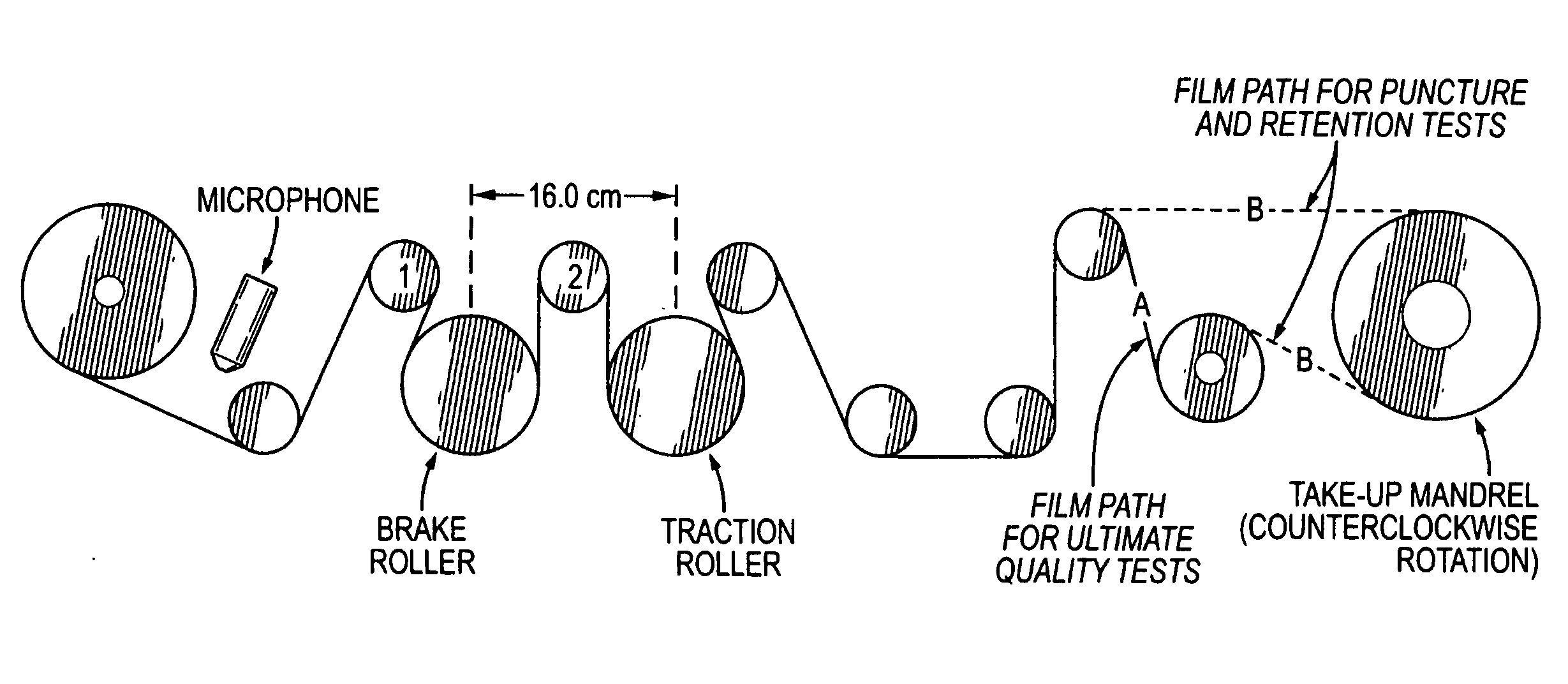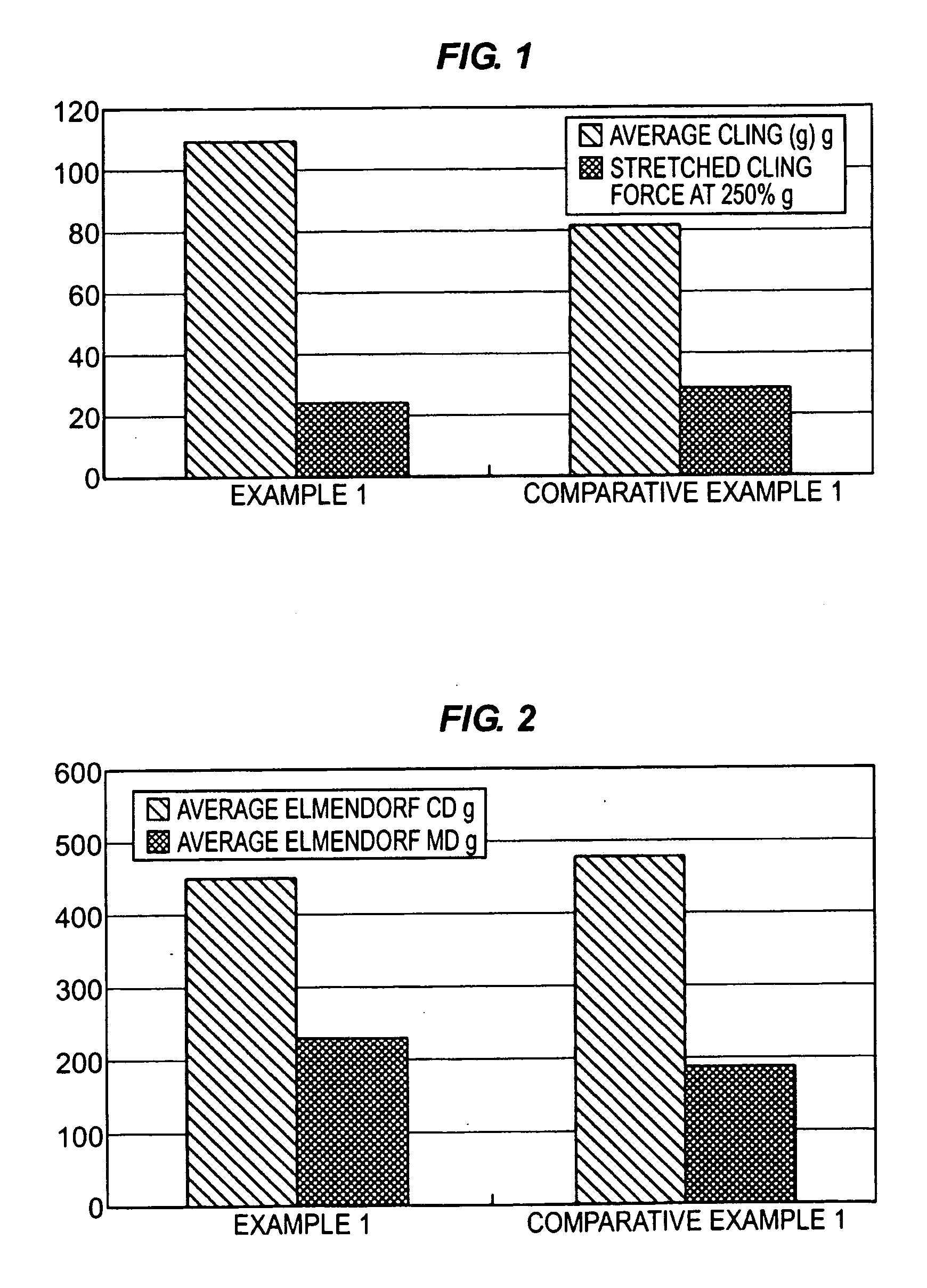Multilayer films
a technology of multi-layer films and films, applied in the field of multi-layer films, can solve the problems of difficult unwinding efficiency of films comprising pibs, high unwinding noise level, and unusable packaged goods for intended purposes, and achieve the effects of preserving freshness, hygienic, and hygieni
- Summary
- Abstract
- Description
- Claims
- Application Information
AI Technical Summary
Benefits of technology
Problems solved by technology
Method used
Image
Examples
example 1
5 Layer Cast, Stretch Film
[0087]A five layer cast film having a total thickness of 23 microns was fabricated using a four extruder line (two extruders of 120 mm diameter screw, one extruder of 160 mm diameter screw, and one extruder of 90 mm diameter screw), using a melt temperature of 250° C., a die width of 4 m, die gap of 0.7 mm, a line speed of 560 m per minute, and an output of 3.4 MT per hour. The five layer film configuration was A / B / C / B / D wherein layer A comprises 10% of the total thickness and layer D comprises 15% of the total thickness and each of the two B layers and one C layer comprise 25% of the total thickness. The A layer comprised 100% by weight of a linear very low density ethylene-octene copolymer having a a density of 0.904 g / cm3 and a melt flow rate of 4.0 g / 10 min. The two B layers comprised 100% by weight of a linear low density ethylene-octene copolymer having a density of 0.918 g / cm3 and melt flow rate of 3.4 g / 10 min. The C layer comprised 100% by weight o...
example 2
32 Layer Cast, Stretch Film
[0090]A 32 layer cast film having a total thickness of 23 microns was fabricated using a four extruder line (three extruders of 33 mm diameter screw and one extruder of 25 mm diameter screw), using a melt temperature of 205° C., a die width of 30 cm, a die gap of 0.8 mm, a line speed of 18 m / min. and an output of 6 kg / hr. The 32 layer final cast film configuration was made by first making an A / B / C / B structure which was multiplied by 2 and then further multiplied by 4 to obtain the 32 layer final cast film. Useful multiplication techniques and equipment may be found in, for example, U.S. Pat. Nos. 5,094,793; 5,628,950; 5,202,074; 5,380,479; and 5,540,878. Layer A was made using the 25 mm diameter screw extruder and layers B. C, and B were made using the 33 mm diameter screw extruder. Each layer in the 32 layer cast film comprised 100% by weight of a linear low density ethylene-octene copolymer having a density of 0.92 g / cm3, a melt index of 4.0 g / 10 min. (1...
example 3
32 Layer Cast, Stretch Film
[0092]Example 2 was repeated except that an enhanced linear low density ethylene-octene copolymer having a density of 0.916 g / cm3, a melt index of 4.0 g / 10 min., and a melt flow rate ratio (I10 / I2) of 6.9 currently sold as Elite 5230™ by The Dow Chemical Company was employed in place of the linear low density ethylene-octene copolymer used in Example 2
PUM
| Property | Measurement | Unit |
|---|---|---|
| thickness | aaaaa | aaaaa |
| total thickness | aaaaa | aaaaa |
| density | aaaaa | aaaaa |
Abstract
Description
Claims
Application Information
 Login to View More
Login to View More - R&D
- Intellectual Property
- Life Sciences
- Materials
- Tech Scout
- Unparalleled Data Quality
- Higher Quality Content
- 60% Fewer Hallucinations
Browse by: Latest US Patents, China's latest patents, Technical Efficacy Thesaurus, Application Domain, Technology Topic, Popular Technical Reports.
© 2025 PatSnap. All rights reserved.Legal|Privacy policy|Modern Slavery Act Transparency Statement|Sitemap|About US| Contact US: help@patsnap.com



